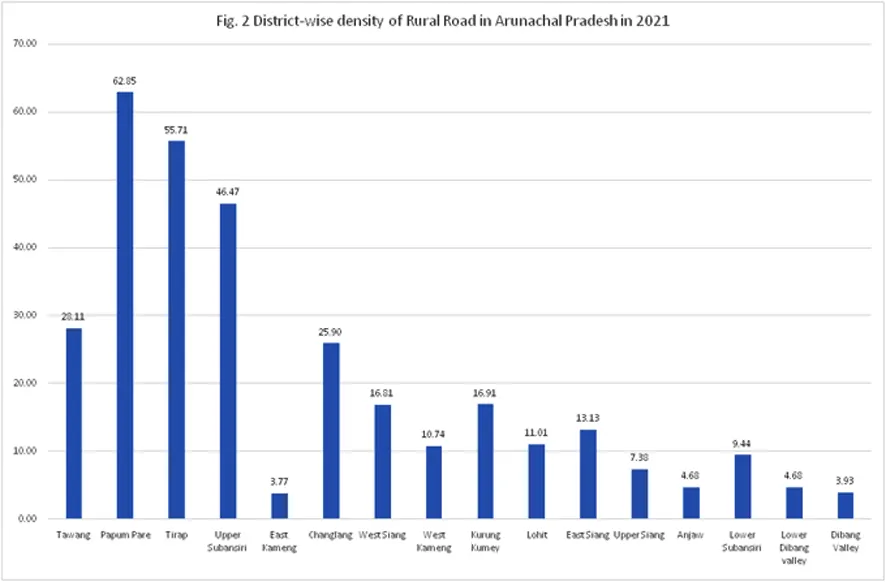[ Dr Ashi Lama ]
Connectivity is vital for socioeconomic development of a region. It facilitates smooth movement of people, boosts production, and promotes trade.
Arunachal Pradesh, a hilly state of Northeast India, has witnessed a significant improvement in connectivity in the last 15 years under the Look East/Act East policy. The paper on the above topic was presented by the author at the UGC-SAP national seminar organised by the economics department of the Gauhati University on 25 March, 2023 on the theme ‘Connectivity improvements in Northeast India through the Act East Policy since 2014’.
Arunachal Pradesh is a late starter of development process. The development process in the state started with the attainment of statehood in February, 1987. Connectivity in the state was poor due to lack of financial resources, as well as high cost of construction of roads, owing to hilly topography and difficult terrains. The state had been one of the least connected states of India. It was having one of the lowest road densities in the country.
During the British period, the area was kept as a buffer zone and roads were developed in south to north directions to serve colonial interest with little intra-regional connectivity. However, in the last 15 years, the state has received huge impetus in connectivity under the Act East policy and the Prime Minister Gram Sadak Yojana (PMGSY). Road connectivity has improved in the state by leaps and bounds, as indicated by the increase in road density, which is an important measure of surface connectivity.
The total length of the roads in the state has increased from 14.52 thousand kms in 2007 to 33.46 thousand kms in 2015. Further, the road length improved to 40 thousand kms in 2021. The overall density of roads in the state has improved from just 17.34 kms per 100 sq km in 2007 to 39.95 kms per 100 sq km. It further improved to 47.76 kms per 100 sq kms in 2021.
However, the density of roads in the state is still far lower than the national average of 192 kms per sq kms. Further, the density of the national highways in the state is relatively low. It was only 3.35 kms per 100 sq kms in 2015. With the completion of the ongoing highway projects under the Trans-Arunachal Highway project, the density of national highways in the state is expected to rise close to national average.
The analysis of data on district-wise length of roads and road density showed that in 2007 only two districts of the state had road density of above 50 kms per 100 sq kms. Those districts are Tawang (53.64 kms) and Lower Subansiri (50.57 kms). There has been significant improvement in road connectivity in various districts of the state between 2007 and 2021. The density of roads has increased in all districts. Tawang district continued to retain its first position in terms of road density with 97.46 kms per 100 sq kms. The relatively high density of roads in Tawang is mainly due to the presence of a number of military stations and BRTF, as well as its smaller geographical area.
In 2021, five districts of the state had road density of above 50 kms per 100 sq kms (Fig 1), whereas in 2007, only two districts had this achievement. In 2021, Dibang Valley district had the lowest density of roads (only 5.91 kms per 100 sq kms). It can be attributed to its large geographical area and huge forest cover.
Though the road density has improved in all districts, the inter-district disparity in road density has deteriorated over the years. This is indicated by the standard deviation of the district-level road density which increased from 15.06 in 2007 to 27.34 in 2021. This calls for attention of the planners as the objective of the planned economic development strategy is to reduce regional imbalance in economic development.
The analysis of rural road connectivity showed that the state has a very low density of rural roads. The overall density of rural roads in the state has improved from 8.97 kms in 2015 to 14.53 kms per 100 sq kms in 2021. In 2021, Papum Pare district had the highest density of rural roads (62.85 kms per 100 sq kms), followed by Tirap (55.71 kms per 100 sq kms). East Kameng, Dibang Valley and Anjaw districts had the lowest density of rural roads (Fig 2). The study found wide inter-district variations in rural road connectivity.
Regarding railway connectivity, the state was put on the railway map of the country in the true sense in 2015, when the railway station at Naharlagun was inaugurated by Prime Minister Narendra Modi on 20 February, 2015. Now the state capital is connected with Guwahati, New Delhi and Tinsukia by regular train service.
The start of railway service has greatly eased the transportation problem for the people of the state, particularly students and medical patients. The two trains which connect the state capital with Guwahati are Donyi Polo Express and Satabdi (VISTA) Express. The Arunachal Express, the super-fast train, connects the state capital with New Delhi. Further, the Naharlagun-Tinsukia Express connects the state capital with Dibrugarh and Tinsukia. The railway connectivity is a major achievement in the transportation sector as it can open numerous opportunities for economic progress of the state.
The state used to be among the few states of India which did not have a functional airport. However, the state made a landmark achievement by making operational the airport in Pasighat in East Siang district in May 2018. Arunachal’s first commercial flight landed at the Pasighat airport on 21 May, 2018. Further, the advanced landing ground in Tezu in eastern Arunachal was made operational for civilian aircraft in August 2021. The advanced landing ground in Ziro valley was also operationalised for commercial flights from 30 October, 2022. In a major boost to air connectivity, the state capital was put on the air map of the country with the inauguration of the Donyi Polo Airport in Hollongi on 19 November, 2022 by prime minister. It is a landmark in the connectivity history of the state.
Presently, the state capital is connected by air to Kolkota, Mumbai, Delhi and Guwahati. The improvement in connectivity is likely to boost the state’s economy through creation of business, income and employment opportunities in various sectors. It is expected to give a fillip to agriculture, horticulture and tourism in the state, in which the state has tremendous potential. The study reveals that the state has made immense improvement in connectivity in the last 15 years. However, there are certain issues in connectivity in the state, which are: poor rural connectivity, low density of rural roads, low density of national highways, wide inter-district disparity in road density, high proportion of un-surfaced road, and delay in maintenance work as well as completion of road projects. The policy should focus on reducing inter-district disparity in connectivity, improving rural connectivity, timely completion of projects, connecting more districts and towns by railway and major cities by flight services for overall socioeconomic development. (Dr Ashi Lama is associated with the economics department of Rajiv Gandhi University.)





